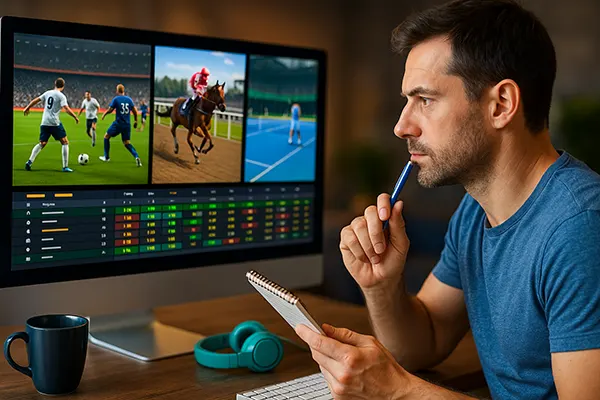
Developing Strategies for Virtual Sports Betting: Is There a Formula for Success?
Virtual sports betting has become increasingly popular, attracting both seasoned gamblers and newcomers. The appeal lies in its fast-paced nature and the ability to bet on simulated sports events at any time. However, unlike traditional sports betting, virtual sports are driven by algorithms rather than real-life performances. This poses the question: is it possible to develop a reliable betting strategy, and if so, what factors should be considered?
Understanding Odds Formation in Virtual Sports
One of the most significant differences between virtual sports and traditional sports betting is how odds are calculated. In virtual sports, odds are generated through complex algorithms designed to mimic the unpredictability of real-life events. These algorithms incorporate various variables, including team strength, historical data, and random number generation (RNG), ensuring that each match outcome is unique and cannot be accurately predicted based on past performances.
Because the outcomes are algorithmically generated, bettors should be cautious when attempting to apply conventional sports betting strategies. Unlike physical sports, where factors like injuries or player form can influence the result, virtual sports lack such variables. Therefore, understanding how the system calculates odds is crucial when devising a betting strategy.
Moreover, some virtual sports platforms may offer insights into how their odds are structured. Bettors should explore available information to understand the factors influencing the odds and to determine whether the odds are consistent or fluctuating based on specific algorithms.
Can Statistical Analysis Predict Virtual Sports Outcomes?
Given that virtual sports outcomes are based on algorithms rather than actual athletic performance, statistical analysis is less straightforward. In traditional sports betting, analyzing past performances and player statistics can give an edge. In virtual sports, however, the randomization element introduced by the algorithm makes statistical forecasting less reliable.
Nonetheless, some bettors attempt to track patterns in odds changes and outcomes, seeking to identify trends that may hint at how the system generates results. While this approach may occasionally work, it is not foolproof and often leads to misleading conclusions. Thus, bettors should approach statistical analysis with caution and recognize its limitations in this context.
Another potential strategy is to focus on identifying inconsistencies in odds or results that might suggest a pattern in the algorithm. However, given the randomness and fairness protocols in place, such patterns are typically coincidental rather than indicative of a reliable betting strategy.
Successful Strategies for Betting on Virtual Sports
Despite the inherent randomness of virtual sports, some strategies may help mitigate risks and increase potential returns. One commonly recommended approach is to manage one’s bankroll effectively, ensuring that bets remain consistent regardless of prior outcomes. This strategy helps prevent excessive losses during losing streaks.
Another useful method is to focus on betting on specific sports that one understands well. While the outcomes are still unpredictable, familiarizing oneself with the virtual representation of a known sport may offer a slight advantage in making informed decisions. For example, knowing how virtual football odds are structured can help identify potentially favorable bets.
Moreover, bettors may find success by analyzing the average payout rates of different virtual sports. Some virtual games have higher return-to-player (RTP) rates than others, and prioritizing bets on these games could theoretically increase long-term profitability.
Betting Responsibly and Setting Limits
Given the fast pace of virtual sports betting, it is crucial for bettors to set clear limits on both time and money spent. The rapid turnover of events can lead to impulsive betting, which may result in significant losses. Establishing a fixed budget for each betting session can help maintain control.
Additionally, taking regular breaks between betting sessions helps maintain a clear mindset and reduces the temptation to chase losses. Responsible gambling practices are essential, especially in a virtual environment where the outcome of one event has no bearing on the next.
Many platforms offer tools for setting betting limits and self-exclusion options. Utilizing these features is a practical way to ensure that betting remains an enjoyable and sustainable activity.

The Role of Technology in Virtual Sports Betting
As virtual sports betting continues to evolve, advancements in technology are shaping the way these games are designed and presented. Artificial intelligence (AI) and machine learning (ML) play significant roles in creating dynamic and unpredictable simulations, making outcomes harder to anticipate.
With improved graphics and more realistic event simulations, bettors might feel a stronger connection to the virtual games, which can influence betting behavior. It is essential to remain aware of how immersive technology can affect judgment and to maintain a strategic, calculated approach to betting.
Furthermore, transparency about how the algorithms work is becoming a crucial factor for players. Some platforms are beginning to offer more detailed explanations about the software used, giving bettors insight into how outcomes are determined. Staying informed about these technological aspects can aid in developing a more reasoned betting approach.
The Future of Virtual Sports Betting
The future of virtual sports betting appears promising, with continuous innovation expected in both game mechanics and betting systems. As platforms strive to offer more realistic and engaging experiences, bettors must adapt their strategies accordingly.
One emerging trend is the integration of real-time data and interactive elements, potentially allowing bettors to influence outcomes through live decisions. While this feature is still in its infancy, it highlights how virtual sports betting is evolving to blend traditional sports excitement with technological advancements.
As the industry matures, bettors who stay informed about new developments will be better equipped to navigate the challenges of virtual sports betting. Embracing both strategic thinking and responsible gambling practices will remain key to long-term success.
